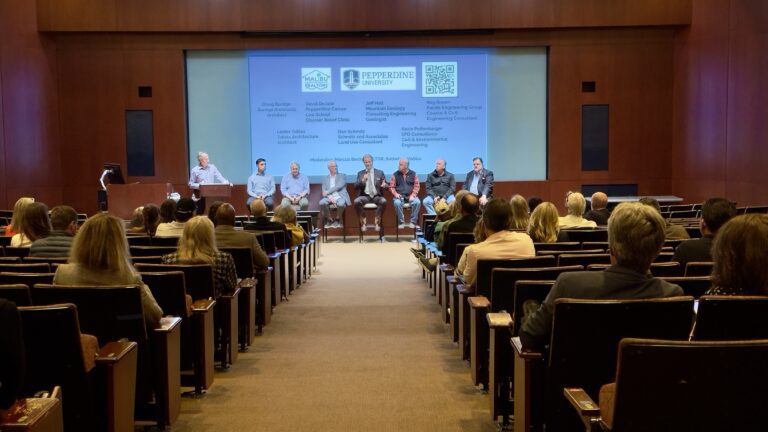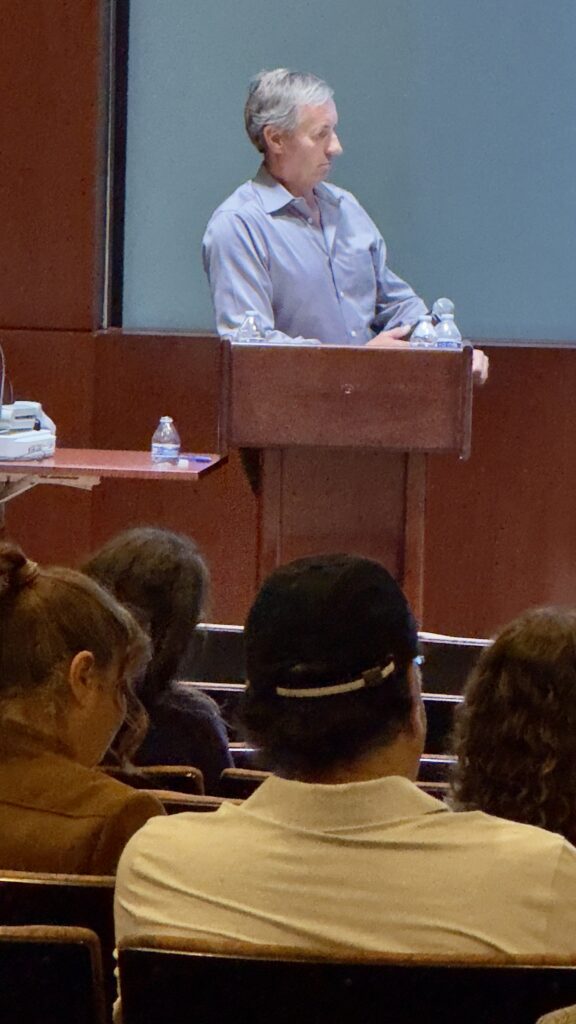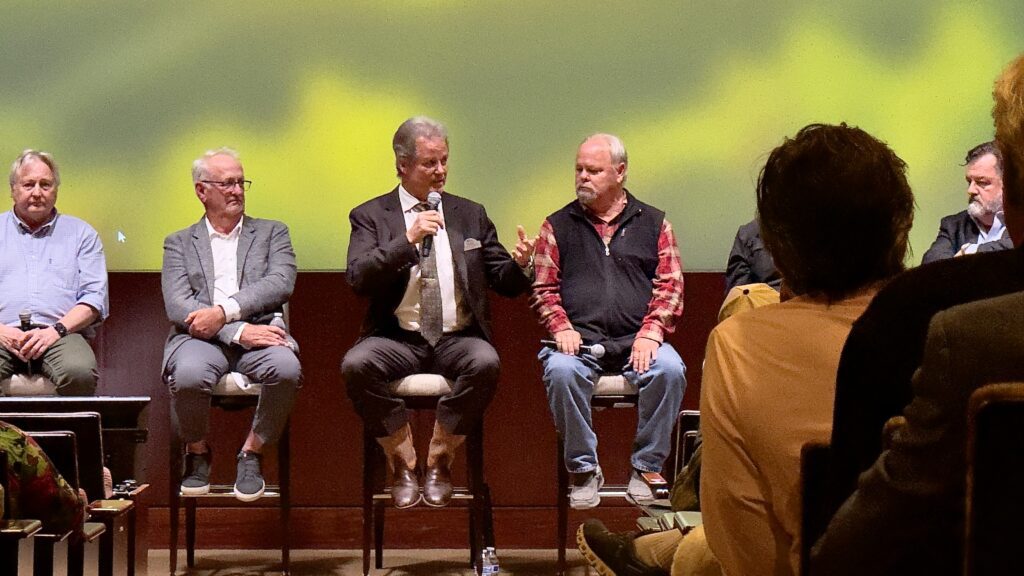
Malibu professionals urge fire survivors to build smart, highlighting the importance of experienced local teams
On a Thursday evening four months after the Palisades fire obliterated much of eastern Malibu, a panel of knowledgeable fire rebuild veteran professionals in the local design-build and land use planning sectors gathered to discuss the potential challenges those who seek to rebuild will confront and to walk them through the permitting processes. David DeJute of the Pepperdine Caruso Law School Disaster Relief Clinic also fielded questions concerning insurance coverage, claims and practices. A very grateful audience listened attentively, visibly full of angst and in the unenviable position of trying to divine what questions to ask as to their individual parcels and what steps they must undergo to successfully rebuild.
The event, held on April 24, was organized by the Malibu Association of Realtors and hosted by Pepperdine. Malibu native Marcus Beck, a Sotheby’s realtor, moderated the lively meeting, which centered on rebuilding concerns unique to both coastal and landside lots.

“Use local design professionals who know how Malibu works with regard to permitting as well as concerning the unique challenges of building on our coastal lots and lots with slopes,” Reg Brown of Pacific Engineering Group Coastal & Civil Engineering advised. “Those who are rebuilding on coastal lots need experienced contractors who have built more than just a sandcastle on our sand because the building materials used are very different — the concrete is different and we have to use epoxy —coated rebar, just to name two examples.”
Chiming in, Beck recounted that when some homeowners who rebuilt after the 2018 Woolsey Fire went to apply for their final permit they were unpleasantly surprised — they were told that their property could not be approved for occupancy because they did not have a space on their parcel that was wide enough for the fire department to turn around. Panelists concurred that if those homeowners had utilized a local team, they probably could have avoided such an unpleasant — and very expensive — delay right at the end of their rebuilding process.
Nodding in agreement, Don Schmitz, a development and permit processing consultant, emphasized the importance of bringing contractors into a homeowners’ rebuilding team early on in the planning process. He advised it was prudent to assemble a team of knowledgeable local design and building consultants. Doug Burdge, a local architect, said it is wisest to have an architect draw a set of plans and bid the job out to local contractors as soon as possible.
Documentation of prior home square footage
Addressing the need for those who are rebuilding to document the square footage of their destroyed homes, the panel emphasized the utility of acquiring a complete set of historical documents consisting of records from the tax assessor, prior permits obtained and proceedings with the county. Such documents are held by the county with regard to structures constructed before Malibu became a city in the early 1990s, and they are registered with the city after it became incorporated and, where appropriate, the Coastal Commission may have documents that could help to define the square footage of a destroyed structure’s legally constructed elements.
“For those structures built in the 1940s, there may not be any records from the city or county and, if you’re lucky, the tax assessor’s records may reference square footage,” Schmitz stated. “Old title reports may reference deed restrictions concerning the size of home that can be built on a property — such information is found in Schedule B of title reports. Another wonderful resource are the aerial photographs dating back to the 1940s that are housed at the Fairchild Library at the University of California Santa Barbara.”
Overall, he noted, it is imperative to prove both the size and square footage of all structures that owners seek to rebuild to the City of Malibu or to Los Angeles County for those rebuilding in unincorporated areas and sometimes, only dated photos are available to meet that obligation.

FEMA floodplain rules affecting beachfront home designs
“The floodplain rules and their base floor elevation requirements affect designs for rebuilds along the coast, and we will have to design homes on stilts and make modifications to driveways and walkways entering the property and garages,” Burdge said. “Folks can pick up the home design they had before and rebuild their house with caissons and concrete slabs to meet those government specifications. It is prudent to include contractors who have local knowledge and who will do the rebuilding in meetings early on.” He noted that the whole house, including a garage, must conform to FEMA’s VE zone requirements, also known as special flood hazard areas, a measurement that pertains to special flood hazards on coastal lots.
Schmitz noted that all newly built homes must have two designated parking spots and interior sprinklers, elements that must be included in construction plans and that will add to the expense of construction. “One cannot build seaward if he wants to benefit from the expedited permitting process allowed by the governor’s executive orders, which eliminates the need for a coastal engineering report in some cases,” he cautioned. “If one expands seaward beyond the destroyed home’s original footprint, he has to obtain a coastal development permit from the Coastal Commission, which is an expensive and time-consuming process.”
If one builds seaward beyond his original home’s contours, he may also have to acquire a determination of the mean high tide from the State Lands Commission before obtaining permits, noted Lester Tobias, an architect experienced in rebuilding in Malibu. He added that one can refer to old surveys as they have control benchmarks that can be used in determining elevations to comply with FEMA requirements.
There are ample records to consult to define the elevation of an old structure, panelists noted. “Los Angeles County’s records and those belonging to the California State Land Commission have some mean high tide maps dating back to 1875!” Beck exclaimed. “That’s a year before Custer’s Last Stand!”
The discussion also addressed the effect of the uncertainty that coastal lot owners are facing regarding whether they must build advanced water treatment systems on their lots or whether a new sewer may be installed to serve their area or the infrastructure necessary to connect their homes to an existing sewage plant would be installed. Brown noted that such uncertainty is an impediment to budgeting for construction as well as starting the rebuild process.
Private view determinations for landside lots
A few attendees queried about how elevating beachfront homes to comply with the FEMA floodplain maps could affect the view corridors for homes across from coastal lots. “Anyone who is concerned about views can request a private view determination during the permitting process,” Burdge explained, discussing the process which involves a city planner visiting a property and documenting a private view corridor. Property owners undertaking rebuilds in Malibu are required to consider any established primary view determinations when designing their new structure, according to maliburebuilds.org.
Whatever insurance money you may have — you’ll need more
The panel addressed concerns that many who lost their homes in the Palisades Fire are under-insured, with DeJute suggesting that insureds be wise about whether and when they might hire a public adjuster.
“An insurer has an obligation to act in good faith toward its insured, and it has a qualified fiduciary duty to pay out insurance proceeds if it is obliged to,” He said. “If the insurer is working with you with regard to paying some proceeds out, let it do that and if there is a dispute regarding coverage later on, you may need to hire an insurance adjuster but doing so a bit later in the process will reduce how much you must pay to that adjuster as they get paid a percentage of the insurance proceeds they address.”
DeJute noted that “those rebuilding have to be highly engaged in all parts of the lengthy process.” He emphasized, “It’s your rebuild — you cannot just delegate everything to an attorney or a public adjuster.”
Increased costs for rebuilding attributable to high demand and possible tariffs
Panelists noted that Malibu will experience a tidal wave of construction work as more than 700 destroyed homes are rebuilt. “Shortages in labor and the higher costs of local supplies will be very daunting due to the unprecedented scope of this disaster,” Schmitz predicted.
Bemoaning the extra costs that those rebuilding will possibly incur to comply with governance requirements before a shovel even goes into the earth to begin the construction process, Burdge stated, “Whatever insurance money you may have — you’ll need more. Therefore, we architects and design professionals advocate the city and county doing whatever they can to make the process more streamlined.”
In that vein, he noted that he favored the city considering allowing for self-certification by some design professionals with regard to some required reports complying with best practices, state and county laws and municipal ordinances. Thosegovernments who are processing permits should, he opined, do “anything that might help expedite the process and reduce costs for those who are rebuilding.”